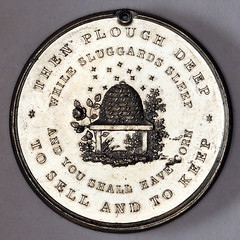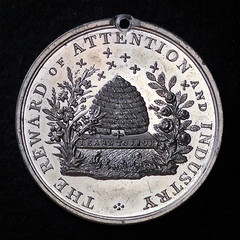
PREV ARTICLE
NEXT ARTICLE
FULL ISSUE
PREV FULL ISSUE
LEARN OF US: THE BEEHIVE ON MEDALS
Last week we mentioned a couple of headline articles in the latest issue of The MCA Advisory, a publication of the Medal
Collectors of America. Another great article in that issue is John Sallay's piece entitled "LEARN OF US: The Beehive as Medallic
Object Lesson". With permission, a lengthy excerpt is published below, along with just a couple of the many great photos
accompanying the article. -Editor
 
All of the medals we collect were originally created for some primary purpose. Some were commemorative, some awards, some commercially produced for sale to collectors or tourists, and others were purely artistic expression. Among school award medals, a number were also intended – or perhaps even primarily intended – to be instructive. They were designed to reinforce important lessons, values, or behaviors in the children who received them. One favorite device was the beehive, symbolizing the virtues of diligence and cooperation. In Roman times, bees became a potent symbol of dedicated hard work, community, cooperation, and harmony. A bee colony is a super-organism often exceeding 50,000 workers, where no individual can survive independently, and every member of the colony has an important job to perform. Even the queen is not self-sufficient, requiring several attendant female workers to feed, warm, and protect her, and a few male drones to…well, you know (and nothing but that, incidentally). Because of this nearly unique community behavior and their perceived diligence, bees or their beehives have been adopted as central iconography by several well-known organizations that value these traits, such as the Freemasons and Mormons (and subsequently the State of Utah). Given the bees’ diligent, hardworking, community behavior, it’s not surprising that the beehive was often used as the central device on school award medals. Beehives were certainly not the only symbols used, but they came close to being the perfect cultural object lesson for children in the late-18th through the 19th centuries, as primary education became more universal. German-speaking European countries, England and its North American offshoots, the United States and Canada, produced the greatest number of these beehive medals, but examples are also known from Denmark, Hungary, and a few other countries. While the beehive itself was sometimes enough to get the idea across, more often the intended message is spelled out explicitly. For example, many of the English medals have legends like a simple “Industry”, “Learn Of Us”, and/or “Learn To Live”. Others have a more elaborate legend such as “By Industry We Live, By Perseverance, Excel” or “From Labour & Industry Great Blessings Flow”. The German, Danish, and Hungarian medals tend to have a message more like “useful to themselves and others” in their native language or Latin. One of the more delightful pieces, by Joseph Davis, shows a boy on the obverse studying in front of a bust of Franklin and the legend, “God Giveth All Things To Industry”; on the reverse is a beehive surrounded by the continuation of the Franklin quotation, “Then Plough Deep While Sluggards Sleep And You Shall Have Corn to Sell And To Keep”. So Learn Of Us Indeed! For more information on the Medal Collectors of America (MCA), see:
To read the earlier E-Sylum article, see:
Wayne Homren, Editor The Numismatic Bibliomania Society is a non-profit organization promoting numismatic literature. See our web site at coinbooks.org. To submit items for publication in The E-Sylum, write to the Editor at this address: whomren@gmail.com To subscribe go to: https://my.binhost.com/lists/listinfo/esylum All Rights Reserved. NBS Home Page Contact the NBS webmaster 
|